-
Compliance
Assistance in the design, implementation and monitoring of Compliance programs within the framework of local and international regulations (FCPA, Corporate Criminal Responsibility Law), including course delivery.
-
Sustainability
Learn how our sustainability services can help you go beyond and build a strong reputation, attract committed investors and generate long-term sustainable financial results.
-
Forensic
The services offer includes expert advice in litigation resolution and the development of procedures in legal/digital forensics and cybersecurity.
-
Human Capital solutions
Grant Thornton's Human Capital division has a team of professionals determined to accompany individuals and organizations throughout the relationship between the employee and the organization.
-
Organizational restructuring
Advice on operational restructuring to companies in difficulty, their creditors or other interested parties.
-
Services to the Government and the Public Sector
Financial audit projects and special technical and concurrent reviews of programs of national and subnational governments financed by International Credit Organizations. Special projects for government entities, public and mixed companies.
-
Valuation Services
We provide stock, business, asset, and liability valuations in support of negotiations, account structuring, and tax opportunities.
-
Transaction Advisory Services
The service offer includes financial due Diligence, operations services, business and strategic intelligence, ratings, advice on mergers and acquisitions, capital markets and debt advice.
-
Academy - Empowered by Grant Thornton Argentina & Perú
Academy is an e-learning platform that emerged as a joint initiative of Grant Thornton Argentina and Grant Thornton Perú. It is designed so that everyone can acquire new skills in accounting, auditing, taxes, technology and business through access to multiple courses and certifications.
-
External audit
We offer services of external audit of financial statements, assurance reports, agreed-upon procedures reports and certifications, due-diligence and take-over of companies.
-
Audit methodology and technology
At Grant Thornton we use a single audit methodology across our global network. We apply it through LEAP, an integrated software audit tool. Get to know it now.
-
Professional standards and training
Our IFRS advisors can help you navigate the complexity of the standards so you can spend your time and effort on your business.
-
Prevention of money laundering and financing of terrorism
At Grant Thornton we provide advice to our clients in the development of an Asset Laundering and Terrorist Financing Prevention strategy that allows them to prevent risks in a comprehensive manner.
-
Tax outsourcing
Taxes have a significant impact on business decisions. At Grant Thornton, we respond quickly and design tailored solutions to ensure organizations are not adversely affected.
-
Payroll
We have the experience and the know-how to perform payroll for various industries, including those in which trade unions and workers' organisations are active.
-
Accounting, administration and finance services
Effective accounting and financial advisory are necessary for the success of an innovative and forward-thinking organization. We provide our knowledge and experience so you can stay focused on your business's core activities.
-
Start-up of companies
The early stages of a business are key to its success. Therefore, it's important to have experts who manage and administer business resources. Learn about our solutions to help you build your company.
-
Financial statements audit
We offer services of external audit of financial statements; assurance reports, agreed procedures and certifications; due-diligence and take-over of companies.
-
FIU Independent External Reviewer - AML/CFT
We participate in the implementation of the requirements of the FIU in leading companies and our services ensure an orderly framework, optimizing the investment.
-
Internal audit
An internal audit helps identify gaps, deficiencies, and potential for inherent risk in all facets of the organization.
-
Legal audit
The monitoring of the legal area is usually a complex and difficult task for organizations, which however cannot be neglected.
-
Creation and acquisition of Financial Entities
We have the knowledge and experience in activities related to the acquisition and creation of financial entities, both locally and internationally.
-
Responsible for regulatory compliance
At Grant Thornton we offer the service of acting as "Responsible for Regulatory Compliance and Internal Control" for companies that requested registration as Settlement and Clearing Agent and Trading Agent.
-
IT Internal Audit
IT has been, and will increasingly be, a key factor for success and operational efficiency in all industries. Innovations such as the cloud and virtualization, and new threats around data security, have reinforced the importance and increased the risks associated with the use of technology for our clients.
-
Cybersecurity
As sophisticated digital manipulations become more prevalent, organizations must strengthen their defences and effectively protect themselves from threats and recognize those that are not. Organizations must act quickly to strengthen trust and resilience. A combination of enhanced security capabilities, robust controls, and employee education and awareness is critical.
-
ITGC Controls
Information Technology General Controls (ITGC) are a set of policies that ensure the effective implementation of control systems throughout an organization. ITGC audits help verify that these general controls are implemented and functioning correctly, so that risk is appropriately managed.
-
Global Mobility Services
Sending someone abroad involves liabilities and obligations. We offer interesting solutions to minimize the tax burden for both parties.
-
Direct Tax
We provide clear and practical solutions that meet your specific business needs, in the most tax-efficient way possible.
-
Indirect Tax
Grant Thornton's tax teams take a rigorous approach to help you meeting your tax obligations, whatever challenges you may face along the way.
-
International taxes – Transaction support
We offer our international experience in the field and make available the resources to plan and adequately comply with regulatory frameworks.
-
Services to private clients
Wherever you are in the world, our tax specialists can help you with your interests and investments abroad.
-
Clean energy and technology
Growing demand, development of new ways of energy and a need for a sustainable future: we support our clients in these changes to be one step beyond their competitors.
-
Mining
Our flexible, partner-led teams are dynamic and focused on development. We take time to understand the details of the client’s business and offer unique solutions.
-
Oil and gas
Our Oil & Gas teams have the deep knowledge, wide experience and vision needed to offer our clients practical solutions adapted to their businesses.
-
Banking
Grant Thornton offers meaningful and accurate solutions for operational and transactional issues, litigation and administrative disputes in banking.
-
Private capital
We gather international teams of experts in corporate finance, restructuring and recovery, tax and insurance services to deliver customized solutions from initial investment, through development stages until the end of each project.
-
Fintech
We work to take advantage of all opportunities and manage industry risks, allowing our clients to always be one step beyond their competitors.
-
Asset management
We have specialized teams in more than 140 markets delivering solutions regarding insurance, taxes and advisory to global, international, regional, local asset managers.
-
Insurance
Thanks to our specialized team we offer accurate solutions for operational and transactional matters, litigations and administrative conflicts.
Digital transformation investment is on the rise throughout the enterprise, increasingly focusing on strategic opportunities. While organizations are moving forward gradually when it comes to adopting new technologies, they do so at a steady pace in order to both enable and disrupt current and future business models. The finance function is set to benefit from these strategic opportunities. At the same time, CFOs are playing an increasingly important role in influencing decisions related to technology and tapping into future opportunities with a defined purpose and strategy.
According to our latest research study — 2018 CFO Insights on New Technologies — investment in digital transformation is crucial for a competitive advantage. Grant Thornton partnered with CFO Research and surveyed 304 CFOs and other senior financial leaders, from companies with revenues between $100 million and over $20 billion. Overall, more than three quarters of the executives surveyed agree that digital transformation is critical, 23% in the short-term and 56% in the long-term.
Investing strategically in digital transformation
To stay competitive in the market, more than two-thirds (69%) of our executive respondents plan to increase their investment in digital transformation in the coming year. Of these, four in ten respondents, planned an increase of more than 10% in the next twelve months. Notably, while some organizations admitted playing catch-up with their competition, or matching their competition’s offerings, 41% of respondents indicated that their digital transformation investment efforts are directed at overtaking their competition through differentiation.
While investment strategies for digital transformation so far have been influenced by the desire to improve operational performance and reduce costs, future investment strategies will zoom in on more strategic opportunities, such as improving customer experience, competitive differentiation, or new products/innovation.
In the short-term, future differentiation will certainly depend on creating an exceptional customer experience. Our research revealed a significant difference in executives’ top 10 investment priorities now versus in the future. When it comes to executives’ goals today, compared to those prioritized in the next two years, the top four goals shift (as shown in Figure 1 below). In the future, customer experience tops the ranking, and competitive differentiation enters the top four goals. This represents a shift in focus from internal, operational concerns to external brand perception and service and product offerings that at least match up to the competition.
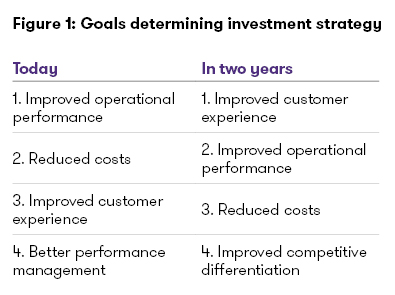
From our executives’ responses, it becomes clear that, in the next two years, growth will be dependent on customer experience. In addition, other goals related to competitive differentiation move up in the ranking, such as new product development and better innovation support, which, in two years’ time, both sneak up three positions from their current ranking.
These current and anticipated goals point to an existing tension in terms of the distribution of funds at the enterprise level. The tension exists between current needs for maintenance and system updates, in contrast to the desire to invest in new automation technologies.
In our survey, executives agreed that their organizations’ top IT challenges were systems complexity, including systems integration across the enterprise, upkeep of legacy systems and IT talent. These foundational, urgent realities require significant investments, which possibly stall the pace of adoption of new technologies in other departments of the enterprise — e.g., the finance function — which could benefit from technology investments, but might be deprioritized in terms of budget, due to immediate technology needs.
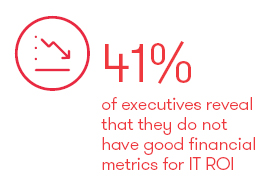
In particular, as new technologies are by definition untested by the proof of time, their success and value to the company is aspirational. Also, investment decisions are made even more complex by the fact that there is fluidity in the organization in terms of determining exact key performance indicators for measuring the financial success of new technologies. As our research suggests, only 12% of executives strongly agree that they have an effective system of measuring financial key performance indicators associated with the implementation of technology.
Competitive success depends on a steady pace of adoption that also makes sense for your company’s priorities because new technologies do hold the promise of alleviating some costly issues for executives, e.g. issues related to risk and compliance. For example, executives indicated that they do intend to prioritize new technology investments for the enterprise that will solve regulatory compliance, as shown below in Figure 2:
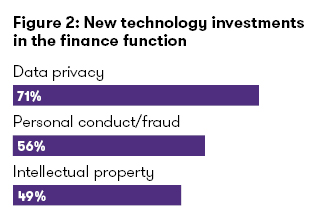
How new technologies can improve the finance function
The survey suggests that the adoption of new technologies in the finance function — now and during the next five years — is correlated with the benefits that bring most immediate value to the company, such as better data quality and mining for strategic analysis, optimized processes, minimizing errors, reduced costs, more streamlined reporting and better process scalability to match growth. As Figure 3 shows, top automated processes focus on streamlining operations and freeing up capital now.
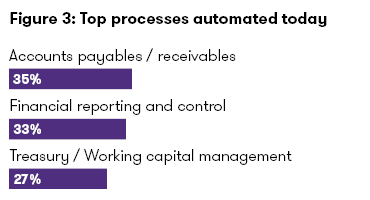
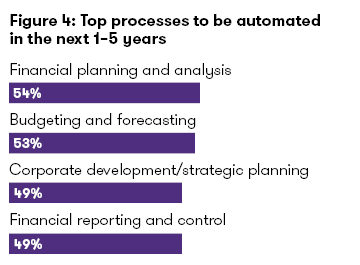
In light of these priorities then, it makes sense that currently, the most widely adopted new technologies are advanced analytics and optical character recognition (as shown in Figure 5 below). In contrast, future investments in automation will focus on better strategy, analysis and predictions for growth (as shown in Figure 4 above). This explains why executives identified advanced analytics (probably with a focus on prediction and prescription) and artificial intelligence, as top projected investments in new technologies in the next one to five years.
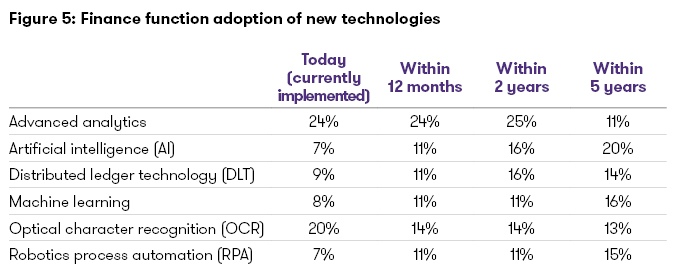
CFO’s role in managing technology decisions across the enterprise
As new technologies are increasingly infiltrating the finance function, the role of the CFO is shifting to require an updated set of technical skills. The CFOs we surveyed confirmed the assumption that CFOs will have to assume many more responsibilities related to technology in the future.
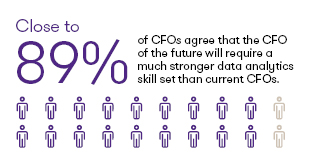
In the short to long-term future, CFOs will need a strong technical background. The role will require a person with a strong understanding of such responsibilities that today might fall within the realm of a data scientist/CTO/CIO. What will be required of future CFOs is a technical mindset that will include a strong understanding of the risks that new technologies bring about.
Current CFOs already report starting to assume technology-related responsibilities, as shown below in Figure 6 and Figure 7:
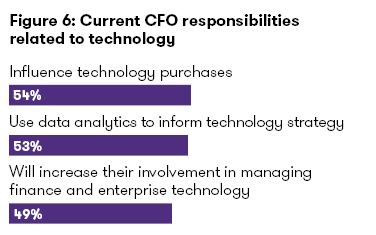
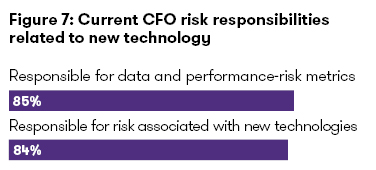
In the current state of the finance function, where new technology opportunities and risks have already started to influence the finance function, today’s CFOs have found the immediate, implementable solution of establishing a better collaboration with their executive IT counterparts. The finance function can work with IT to ensure that they support each other and that they collectively make the best technology decisions for the enterprise.
Filling in the skills gap
The consensus on the required technical expertise of the future CFO brings about the larger question of attracting and keeping necessary talent. Filling skill gaps is and will remain a conundrum, with only temporary solutions.

One such solution that three quarters of CFOs embraced was to embark on a personal journey of updating their data analytics skill set in 2018. Yet, the big skill-gap question of the future still focuses not only on securing leadership talent for enterprise growth in the digital age, but also on staffing the finance function, and other functions, once automation technologies become more widespread.
How will companies retain and retrain current staff? Or will they? In our survey, executives indicated that their preference is to retrain existing staff (52%), rather than recruiting new staff (20%), or outsourcing to a third party (17%).
Conclusion
There is no quick solution for implementing digital transformation. It is rather a journey with several phases, where each phase enables the other. When achieved at a manageable pace, digital transformation can give executives the confidence that they can balance today’s operational needs with taking strides towards future innovation. To achieve this manageable pace, executives should take a step back and understand their short and midterm goals in three areas: 1) operational excellence; 2) customer and employee engagement; and 3) competitive advantage. Another factor that they might have to take into consideration is talent. By taking this internal assessment, the finance function has the opportunity to not just drive increased operational visibility, but also operational efficiencies that can free up investment dollars for broader strategic digital transformation efforts.
